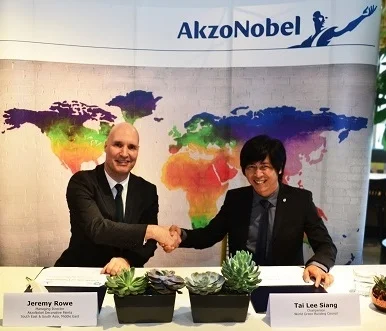The partnership between AkzoNobel and World Green Building Council will promote collaboration on sustainability and green buildings in Asia Pacific. Mallika Naguran reports.
7 July 2017, Singapore. AkzoNobel signed an agreement in Singapore today to work closely with the World Green Building Council (WorldGBC) as a regional partner of its Asia Pacific network.
The partnership, sealed at an undisclosed sum and lasting for a year, will inject greater impetus toward environmental change within buildings. This begins with the awareness of ‘green building’ significance and impacts through private and public sector symposiums. This comes at the heel of separate partnerships established between AkzoNobel and the green building councils of the Emirates and Pakistan in the last 12 months. AkzoNobel has also joined the WorldGBC's corporate advisory board in September 2016.
The partnership between AkzoNobel and WorldGBC aims to boost knowledge and relevance of green building practices and concepts to the public and industries of Asia Pacific. Left - Jeremy Rowe of AkzoNobel; Right - Tai Lee Siang of WorldGBC.
AkzoNobel is a global market player in paints and coatings, and a producer of specialty chemicals. Headquartered in Amsterdam, it has operations in around 80 countries with brands such as Dulux, Sikkens, International, Interpon and Eka.
Government regulations and incentives may serve as primary drivers for sustainable development in some Asia Pacific cities, but not all. As such, the private sector, particularly industry product and solution providers, could step up to the task of providing expertise on resource-efficiency and environmental innovations to the building and construction communities.
“We need to empower our community to drive change, and in order to achieve better results, there needs to be more industry involvement and adoption of sustainable practices in every aspect of design, development, operations and more importantly, behavioural change, across entire regions,” said Mr Tai Lee Siang, Chairperson of the WorldGBC.
WorldGBC’s Asia Pacific network comprises 15 Green Building Councils based in Australia, Chinese Taipei, Hong Kong, India, Indonesia, Japan, Kazakhstan, Korea, Malaysia, New Zealand, Pakistan, Philippines, Singapore, Sri Lanka and Vietnam.
Mr Jeremy Rowe, Managing Director at AkzoNobel Decorative Paints, South East & South Asia, Middle East, said, “We’re committed to developing a more sustainable business and creating more value from fewer resources. We are taking on a ground-up approach by encouraging a continuous regional dialogue through the ‘Human Cities’ series of symposiums in several cities including Vietnam, Singapore and Indonesia. These are held in Asia where government and private sector will jointly sit together.”
The Positive Impacts of Green Buildings
Going beyond the building sector, the partnership between AkzoNobel and WorldGBC ultimately aims to increase sustainability knowledge and relevance of green building practices and concepts to the members of the public.
Mr Tai noted that, “One of the key challenges is relating the benefits of green buildings to the man-on-the-street, but not over-simplifying the environmental message. While there is growing interest in topics like climate change, health and wellness, and liveability, there can be more information on how green buildings can support better and more productive lives.”
As an example, the Harvard School of Public Health study has shown that people in well-ventilated offices with low volatile organic compound (VOC) emissions recorded a 101% increase in cognitive scores.
Mr Rowe said, “There is ample opportunity to boost green product innovation that benefits consumers. In the last five years, we invested €1.83 billion in research and development. Over 50% of our innovations will provide distinct sustainability benefits for our customers and their value chains, according to targets AkzoNobel has set.”
In line with this, AkzoNobel’s Human Cities Initiative underscores their commitment to creating everyday essentials to make people’s lives more liveable and inspiring. Since it was launched in 2014, the Human Cities initiative has resulted in 300 projects involving 9 million people worldwide.
AkzoNobel's Dulux Professional Weathershield has claimed to deliver high standards in product performance and weather protection with one less coat. This translates to cost and time savings for the building industry, with purported result of up to 30 percent increase in productivity.
Towards Zero Carbon in 2050
The partnership between AkzoNobel and the WorldGBC comes in response to WorldGBC’s recent report, which calls for a dramatic and ambitious transformation towards a 100% net zero carbon built environment. To keep global warming well under two degrees Celsius as committed in the Paris Agreement, all buildings must operate at ‘net zero carbon’ by 2050.
AkzoNobel’s own Planet Possible sustainability agenda aims to be carbon neutral and use 100% renewable energy by 2050.
“We are charting a scientific path towards zero carbon by 2050,” added Mr Rowe. “Through this partnership, we hope to increase momentum of the green agenda and encourage sustainability and innovation worldwide.”
Related articles on Gaia Discovery:
AkzoNobel partners with Ground-up Initiative's Kampung Kampus


